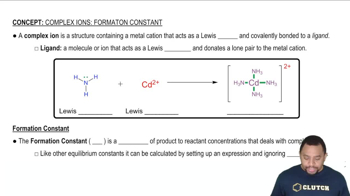Here are the essential concepts you must grasp in order to answer the question correctly.
Complex Ion Formation
Complex ion formation occurs when a metal ion, such as Ag+, binds with ligands, like CN-, to create a more stable species. In this case, the silver ion forms the complex ion [Ag(CN)2]-, which is colorless. The stability of this complex is quantified by the formation constant (Kf), indicating the extent to which the complex forms in solution.
Recommended video:
Complex Ions and Formation Constant
Equilibrium and Kf
The formation constant (Kf) is a measure of the equilibrium position for the formation of a complex ion from its constituent ions. A high Kf value, such as 3.0 x 10^20 for [Ag(CN)2]-, suggests that the complex is favored in solution, meaning that the concentration of free Ag+ ions will be very low when the complex is formed. Understanding Kf is crucial for calculating the concentration of uncomplexed ions.
Recommended video:
Dilution and Concentration Calculations
When mixing solutions, the concentration of each component changes due to dilution. In this problem, equal volumes of 2.0 x 10^-3 M AgNO3 and 0.20 M NaCN are mixed, which requires calculating the new concentrations after dilution. This involves using the dilution formula (C1V1 = C2V2) to find the initial concentrations before considering the formation of the complex.
Recommended video:
Dilution Calculation Example




